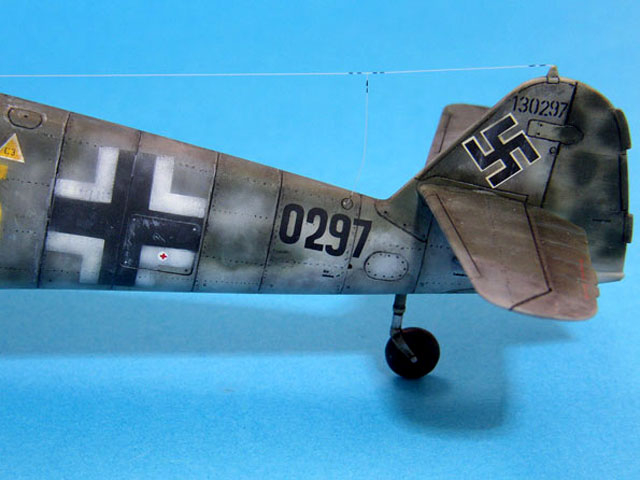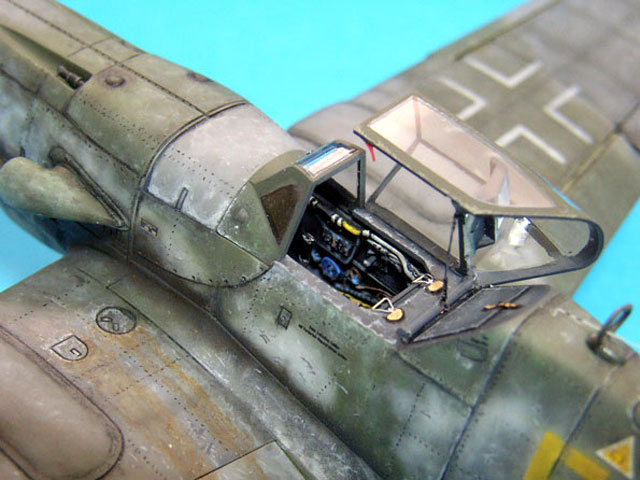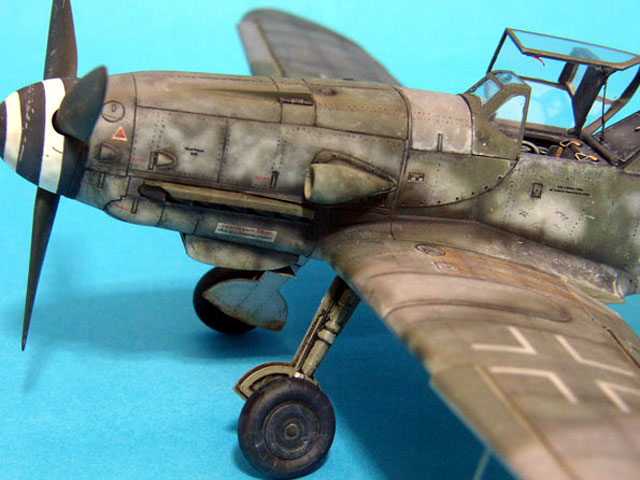|
Messerschmitt Bf 109G-10
by Francisco Carlos Soldán
Alfaro
|

|
|
Messerschmitt Bf
109G-10/R3, Yellow 5, 10/JG 51, Feldwebel Horst. Petzschler , 4 May,
1945 |

Hasegawa's
1/48 scale Messerschmitt Bf 109G-10 is available online from Squadron.com
Feldwebel (Sergeant) Horst Petzschler received orders
to leave his base on the banks of the Weichsel river and transfer to the
Island of Bornholm. The surface of the aerodrome was in very bad
conditions and when taking off, two of their companions crashed whereas
the Messerschmitt of Petzschler lost its ventral fuel tank leaving him
without sufficient fuel: barely for one hour and twenty minutes of flight.
It never got to its destination of Bornholm. Due to a
directional error, when he flew over the airport of Bulltofta in Sweden,
Petzschler landed, thinking that this was the airport at Copenghagen.
Although already practically without fuel, he managed to land the
Messerschmitt without misfortunes.

The plane was sent to Bromma the 8 of August of 1945
to be given to the Soviet authorities. Nevertheless, during the flight
trials, on 27 of August, the plane crashed and was left for taking apart.
Petzschler remained interned in Sweden until January
of 1946, when he was sent to Russia by boat. It remained during three
years in different prisoners of war camp until it was repatriated the 22
of September of 1949. At the moment, Petzschler lives in the United
States.
The Bf 109G-10 as flown by Petzschler was the fastest
version of the series Bf 109 G, with a top speed of 690 km/h at 7,500
meters. The power plant was a Daimler Benz DB 605 DCM that developed power
at takeoff of 1,800 h.p.
Hasegawa's
1/48 Scale Messerschmitt Bf 109G-10
|
As almost always, I turned to possibly the best
version on the market of the famous German fighter, Hasegawa, in this
case, reference JT 64 corresponding to the Bf 109 G-10.
I decided to make this version due to an accidental
encounter. Staring at the profiles of Luftwaffe Fighter Aircraft Profile
Vol. One, of Claes Sundin and Christer Bergström, I ran into with the
profile of the plane of Petzschler. (pag 126/127). I now had a photo of
the real aircraft and a magnificent profile (although the interpretation
of the colors that makes the author is not of consensus). Because to me I
like the warplanes that raise the challenge to present/display hard
punished them by the conditions of the time, I decided to successfully
obtain the maxima information possible and to investigate if granaries in
the market exist. To first helped me my good Juliá Herrero friend; as far
as the second, those of EagleCals #16 which presented markings for this
particular aircraft. Analyzing the few existing photos of the real
aircraft and the documentation available, I decided to get to work.
First, the cockpit.

My good friend Diego Lopez provided me with the KMC
resin cockpit for Hasegawa's Bf 109G-10 - magnificent like always. I
painted it with the usual RLM 66 and, as always, with acrylics of Vallejo
to obtain to the effects of depth and light required to compensate for the
dark German cockpit interior. I detailed and decorated different dials,
handles and cables with the assistance of abundant references..
Once finished in the cabin, I secured both fuselages
cleanly, only as it they can do these kits - and added the wings.
To improve the plane, I used the excellent
photoetched set from Eduard for Bf 109G. So from the wings I came to
detail to the wheel well and the radiators, as well as the entrances of
these, with the excellent PE of Eduard. It is an arduous work, but the
result makes the pain worthwhile due to the great quality of the finished
product.
Once basic construction is completed, we come to the
controversy about the colours of this aircraft.
According to several publications, the colors vary
from RLM 81/83/76, to RLM 83/75/76. I chose this last one, first choosing
between the sources that to my to understand were more trustworthy, and
later analyzing photos of planes with these two camouflages and comparing
with the apparatus of Petzschler. Like always, in this subject nobody has
the last word, and the final result will be a personal selection.
Due to the hard conditions where it operated, a
forward airfield and at the end of the war, I decided that this Bf 109
G10/R3 would have a good dose of operational weathering, which I
dispatched to taste with the painting effects.
I consider that nothing has to do the finished ones
that they are due to give to the apparatuses of principles of the war in
the Front of Poland and France, of the Campaign of England, those that
fought in Africa or the East, and the planes of end of the WWII. We must
be adapted to every time and make storing of the greater amount of
documentation possible to be able to choose the degree of wished wearing
down. In this instance, the chosen aircraft showed a great deal of
weathering and wear from the conditions in which it was forced to operate.
Painting
First I painted the lower fuselage and the sides of
the aircraft with Gunze RLM 76 Light Blue, with progressive weathering
coats of grey.
The wings were the airbrushed following the original
camouflage pattern for aircraft in service at this time. I sprayed
progressively lighter shades of the upper surface colour to create the
illusion of fading . After I finished with the airbrush, I added more
weathering with oils and acrylics. These were applied with the aid of a
fine brush. I also applied desconchones, in particular around the wing
root and the entry to the cockpit.
The nose required subtle work of mottling and
simultaneous stain produced by the exhaust. These late motors created a
lot of staining, due to their loss of oil and the great production of
smoke. These, as suggested my good friend Diego, were represented by a
red-brown color due to its mixture with the mud, applied with the
airbrush. For the heavy exhaust stains I started with black Vallejo paint.
Once dry, Rust from Gunze is used, but thinned in its dissolvent, and it
is applied of irregular form to brush. Once dry, washes were applied with
thinned Burnt Sienna and Black oil paints, but in an irregular form. The
effect is quite realistic.

Weathering is more accentuated on the lower surfaces
of the aircraft. I worked it over with washes of Burnt Sienna and Black
oil paints to represent oil streaks and general weathering.
Markings
With the main part of the aicraft painted, I masked
and sprayed the wheel wells of the undercarriage in RLM 02 and washed them
in oils to emphasize the structures and rivets. The undercarriage legs and
the cockpit are decorated to part to blend them at the end of the work in
RLM 70. The spinner was painted black and the white spinner spiral was
made with masks.
I varnished the model to the complete one with Marabú
polish, which I find to be excellent for decal preparation. The wing and
fuselage crosses were applied in a group using masks, because for me it is
easier to obtain good effects of faded paint. Nevertheless, the Yellow
number 5 , the Werkenummer and stencils were sourced from the magnificent
EagleCals decal sheet - very recommendable!
Once finished the tedious work of applying the
decals, I sealed the work with a new layer of shining Marabú, followed 24
hours later by a flat coat.
Click on the thumbnails
below to view larger images:
Model, Images and Text Copyright © 2003
by Francisco Carlos Soldán Alfaro
Page Created 11 September, 2003
Last Updated
17 March, 2004
Back to
HyperScale Main Page |
Home |
What's New |
Features |
Gallery |
Reviews |
Reference |
Forum |
Search